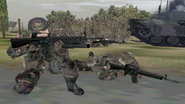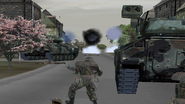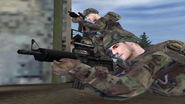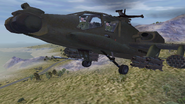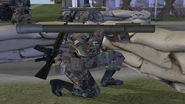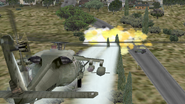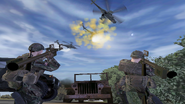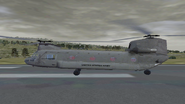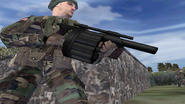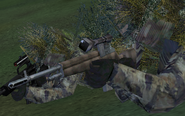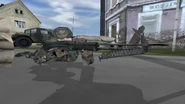|
NOTE: This article is about the United States (U.S.) faction in ArmA: CWA. For other similarly named articles, you may wish to use the following links instead:
|
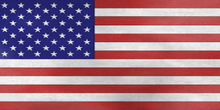
United States flag
The United States (formally the United States of America, alternately shortened to USA) is a BLUFOR faction in ArmA: Cold War Assault.
Background
Soldiers from the U.S. Army represent the vanguard of NATO's presence in the Malden islands group. Bases were established on both Malden and the smaller island of Everon.
Due to Malden's low strategic value, the American garrison initially consisted of just troops-in-training rather than experienced veterans. U.S.-led NATO forces primarily catered to refuelling and resupplying aircraft flying between the continental United States and NATO bases in Western Germany.
Prior to 1982, American forces were only based on Malden and were led by General Williams. Command of the garrison was eventually transferred over to Colonel Caper Blake by mid October, 1982.
History
Events of Resistance (1982)
| SPOILER ALERT | ||||||
|---|---|---|---|---|---|---|
NOTE: This section contains spoilers from ArmA: Cold War Assault's 'Resistance' campaign. After Soviet forces led by Col. Aleksei Guba illegally occupy the Independent Republic of Nogova, the U.S. government and its NATO allies were quick to denounce Moscow's "intervention". Simultaneously, the American-led garrison on Malden were placed on a heightened state of alert, though no actual order for the complete mobilisation of troops was called for.
However in spite of their condemnation, NATO as a whole (including the United States) refused to commit actual forces to supporting the partisans overtly. Rather than risk an open confrontation with the Soviets and escalate the situation, the U.S. government opted to secretly aid the guerillas in their struggle. 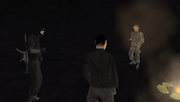 The U.S. special forces team meet with Victor Troska, the leader of the Nogovan Partisans. Officially, no American forces were present on Nogova. But unofficially, a team of elite special forces - led by Major James Gastovski, were dispatched with orders to gather details on the kinds of supplies that the fighters needed to continue their rebellion. Their rules of engagement (ROE) restricted them from supporting the guerillas offensively, but they were permitted to gather information on Soviet troop movements and relay this data to the partisans. On September 6th, the first batch of weapons shipments were delivered successfully to the partisans. Over the coming weeks, increasing amounts of contraband (including advanced American-made surface-to-air missile launchers) were covertly smuggled by the U.S. government and transferred directly to the guerillas. 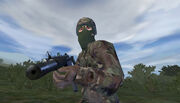 Gastovski's team are finally permitted to aid the partisans offensively. As the guerillas continued their fight, they gradually began to gain the upper hand against the Soviets. With Moscow refusing to give up its hold on Nogova, Gastovski's team were eventually granted clearance to support the partisans offensively. The SOF team partook in many raids against Soviet convoys and facilities across the country. During an operation launched by the partisans to retake the cities of Lipany and Petrovice, the team helped to disrupt Soviet radio communications and also sabotaged their quick reaction units. On September 25th, Gastovski's team intercepted communications from the Soviet commander detailing their exit strategy, which would involve massacring the entirety of Nogova's population in a firebombing campaign to cover their retreat. The SOF team relayed information of this impending attack and requested for immediate backup from the Malden garrison.
However the incumbent commander of the American forces on Malden - General Williams, refused to dispatch reinforcements to support the partisans. Fearing that overt American involvement would significantly escalate the situation, only a formal letter of protest was submitted to the Moscow. Neither the partisans nor the SOF team could spare any time to wait for such bureaucracy. Gastovski's team struck the Soviets on their own accord in an attempt to destroy the bombers, but were ultimately unsuccessful and were driven back. Fortunately, Col. Caper Blake had been listening in on the conversation between Gastovski and Williams. Blake managed to persuade Williams into sending several gunships to assist the partisans just as their troops were about to be overrun. Thanks to the gunships, the majority of the Soviet forces are annihilated in one swift stroke, and Col. Guba's genocidal exit strategy was averted. |
Post-Resistance
In the weeks following the withdrawal of Soviet forces from Nogova, the U.S. government dispatched additional troops to reinforce Malden's garrison.
To further solidify NATO's presence amongst the group of islands, an additional training camp is constructed on the nearby island of Everon to act as a safeguard (and tripwire) against potential future aggression from the Soviets.
Events of Cold War Crisis (1985)
Three years pass, and U.S. forces continue to maintain a presence on Malden and Everon. However, the garrison's troop strength has gradually declined and has largely returned to its pre-occupation numbers.
| SPOILER ALERT |
|---|
NOTE: This section contains spoilers from ArmA: Cold War Assault's 'Cold War Crisis' campaign. On May 5th, "unknown forces" attack and destroy the NATO training camp based on Everon. 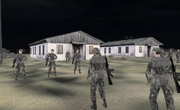 U.S. forces on Malden are mobilised to investigate the "unknown forces". A response force is dispatched by Col. Blake - having been promoted to the billet of commander over the American garrisons on Malden and Everon, to investigate the identity of the "unknown" attackers. However, they literally driven into the sea when a massive wave of enemy forces overrun the troops following a failed attack against the city of Montignac. Two weeks pass without further incident while the U.S. government and its NATO partners seek answers from the Soviet Union, though the Soviets denied any involvement with the attack. To make matters worse, the "Soviet" troops suddenly launched a full-scale invasion of Malden on June 1st. Malden's sea ports are quickly overrun, while Soviet tanks thundered north towards the main U.S. base at La Trinite. A U.S. Navy Carrier Strike Group was immediately dispatched to reinforce the Malden garrison, but it would take several more days before they could arrive. For the time being, what was left of the U.S. forces on Malden were on their own. Soviet forces continued to carve their way through Malden before finally reaching the city of Houdan. The main U.S. airbase itself was now under threat of being completely overrun; all troops - including those still in training, were ordered to prevent Houdan's fall at all costs. 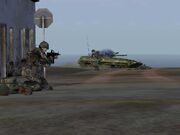 U.S. forces stage a successful breakout at Lolisse. After several hours of fierce fighting, U.S. forces were finally able to claim victory for the first time since the invasion commenced on the 1st. In an attempt to break out of the Soviet stranglehold, numerous counterattacks were launched over the course of several more days, first against the city of Chapoi further south (while also beating back another massive Soviet attack). Breakthroughs were also achieved against the villages and towns of Lolisse, La Riviere, Le Port, and the settlements of Goisse and La Pessange along the western coast. The commander of the Soviet forces is eventually revealed to be none other than (now General) Aleksei Guba; the very same officer who led the Soviet occupation of Nogova three years ago. Guba threatened Col. Blake directly with total annihilation if his men did not immediately withdraw from Malden. Blake disregards the threat, and continues to work on driving off the Soviets from Malden first. He secretly dispatched Maj. Gastovski and Lieutenant David Armstrong on a covert mission back to Everon to enlist the aid of the guerilla fighters based there. U.S. forces regrouped for one final attack against the remaining Soviet troops on Malden, but first they needed to ascertain the location of their camp, which was hidden somewhere north of the town of Goisse. American scouts are able to identify the camp's location after luring their forces out, and raze the camp to the ground after another massive battle. Having destroyed their only remaining base on Malden, U.S. forces - along with freshly arrived reinforcements from the Navy's CSG, prepared to carry out the liberation of Everon as well. With the assistance of the local guerillas, U.S. special forces infiltrated the island days before the main assault to sabotage Soviet defences.  The liberation of Everon begins. On June 20th, U.S. forces stepped foot onto Everon for the first time in more than a month since their first defeat at Montignac. They first secured the main airport north of Everon to clear the way for their heavy armour to be brought in, while air support and special forces teams worked around the clock to ferry troops and cripple Soviet supply lines. U.S. troops continued to make their way south, liberating the villages of Morton, Le Moule, and Regine, before finally retaking the city of Montignac. Their focus then shifted towards the central sector of the island where the Soviets had set up numerous bases near the village of Levie. U.S. tanks rolled through and smashed the Soviet defences, while also driving off a counterattack aimed at dislodging the Americans. The liberation of Everon finally culminated in a total victory for American forces when troops and armour supported by attack helicopters, destroyed the main Soviet headquarters at Saint Pierre. The loss of the HQ forced the remaining Soviet troops to flee back to Kolgujev, their base back in Soviet-controlled territory. 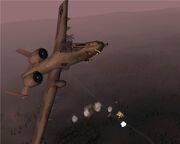 Airstrikes against Soviet bases on Kolgujev begin. Blake widened its front against the rogue Soviets, hoping to destroy them completely to put a decisive end to their threat. Multiple airstrikes were carried out on their bases and an amphibious landing was conducted on the southern end of the island. But in an unprecedented act of defiance however, Guba threatens Blake once again with a televised message, warning that he had nuclear missiles primed and ready to launch if they continued to refuse his demands. With time running short and the flashpoint on Everon now at a breaking point, U.S. forces desperately scrambled to locate the missiles. Maj. Gastovski's team managed to locate the missile site in central Kolgujev and destroyed it mere moments before its launch. Before they could proceed with the arrest of Guba himself however, he inexplicably revealed that a second missile was still stashed away in the north of the island. He was planning to use it to destroy not just himself but all U.S. forces as well, hoping to spark a global conflict between NATO and the Warsaw Pact. Fortunately, Gastovski's team are successful in destroying the second missile and take Guba into custody, putting an end to the crisis on Everon once and for all. |
Post-Cold War Crisis
| « | Meanwhile, tensions appear to have eased on the island of Everon, cause of so much speculation over the past few days, with American forces reportedly engaging hostile troops of unknown origin. In an official statement, the Secretary of Defense revealed that a US training camp on the island had been attacked by a small group of lightly-armed terrorists, led by a disgraced former General of the Russian army. US military sources stated that the assault was a poorly-planned, publicity-seeking maneuver by an extremist organisation, which was easily resisted by American troops. There were no significant casualties. News report on the aftermath of the flashpoint
|
» |
In a bilateral agreement with the Soviet Union, the U.S. government concealed the truth behind the loss of the Everon training camp. President Ronald Reagan publicly denied all reports of American soldiers having fought with Soviet Red Army troops. The Secretary of Defense covered up the deaths of American servicemen on both Malden and Everon.
The truth behind the flashpoint would not be revealed for sixteen more years until documents detailing the incident were declassified on June 22nd, 2001.
Events of State Scarlet (1983)
U.S. forces remained in static positions along the East-West German border despite skirmishes breaking out between West German and East German troops.
| « | The entire scope of the damages occurred is still unclear. The West German Army reports at least 100 casualties. NATO-Allies USA and France in this area have not reported any such figures. Post-crisis news report
|
» |
Eager to avoid an unnecessary escalation of tensions between NATO and the Warsaw Pact, U.S. representatives, alongside their French counterparts, were quick to downplay the incident and reported no West German casualties. Nonetheless, an emergency session is due to take place at the UN Security Council, with leaders from the U.S., France and the Soviet Union participating.
Takistan Civil War (1988-1992)
Throughout the Takistan Civil War, the U.S. government covertly supported the Royalists against the pro-Soviet Takistani Socialists. The government funnelled large quantities of arms and financial aid to support the Royalist war effort.
However, American efforts were completely dwarfed by the overt support provided by the Soviet Union. By the closing stages of the conflict, the Royalists were overwhelmed by the combined might of the Soviets and the Takistani Socialists, and were finally defeated in battle by 1992.
Equipment
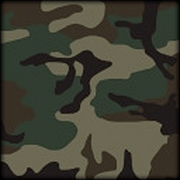
ERDL woodland camouflage pattern utilised by U.S. forces on Malden/Everon.
U.S. Army soldiers mainly wore Battle Dress Uniforms (BDU) concealed in Army's ERDL woodland camouflage pattern. ALICE load bearing rigs were commonly utilised by most troops on the ground, while the PASGT helmet served as the basic combat helmet; also camouflaged in ERDL.
Vehicle crews/pilots on the other hand, wore simple olive drab green overalls with CVC-T56 crewman helmets and SPH-4 flight helmets.
U.S. special forces operatives - otherwise dubbed as "black ops", wore completely black fatigues and chest rigs, along with balaclavas or green ski masks to conceal their identities.
Arsenal
Armoury
Motor Pool
| Vehicle | Role | Notes |
|---|---|---|
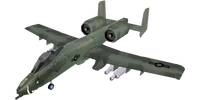 A-10 |
Ground Attack Craft | - Cannot transport any passengers |
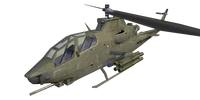 AH-1 Cobra |
Medium Attack Helicopter | - Cannot transport any passengers |
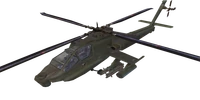 AH-64 |
Heavy Attack Helicopter | - Cannot transport any passengers |
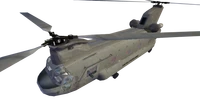 CH-47D |
Heavy Transport Helicopter | - Can transport up to 24 passengers |
 HMMWV |
Light Utility Vehicle | - Can transport up to 3 passengers |
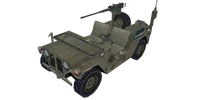 Jeep |
Light Troop Transport | - Variable transport capacity depending on variant |
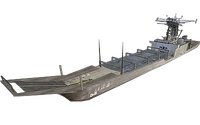 LST |
Troop Ship | - Can transport up to 51 passengers - Automatically rearms helicopters that hover near its flight deck |
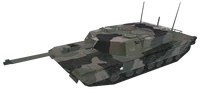 M1A1 |
Heavy Tank | - Cannot transport any passengers |
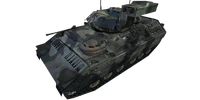 M2A2 |
Infantry Fighting Vehicle | - Can transport up to 6 passengers |
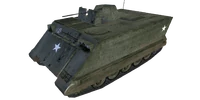 M113 |
Armoured Personnel Carrier | - Amphibious - Variable transport capacity depending on variant - Has dedicated variant that can heal infantry |
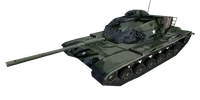 M60A3 |
Medium Tank | - Cannot transport any passengers |
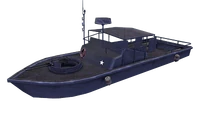 Mark II PBR |
Light Patrol Craft | - Can transport up to 6 passengers |
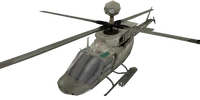 OH-58 |
Scout Helicopter | - Cannot transport any passengers |
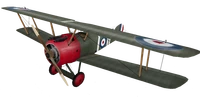 Sopwith F.1 Camel |
Fighter Plane | - Can transport up to 2 passengers |
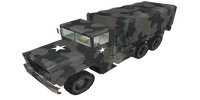 Truck 5T |
Utility Truck | - Variable transport capacity depending on variant - Has dedicated variants that can repair, rearm, and refuel ground vehicles |
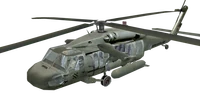 UH-60 |
Transport Helicopter | - Can transport up to 12 passengers |
Gallery
See also
- Soviet Union (OPFOR counterpart)
- United States Army (Primary land force branch, Armed Assault/ArmA 2: OA)
- United States Marine Corps (Expeditionary assault force, Armed Assault/ArmA 2)
| Factions - BLUFOR (ArmA: Cold War Assault) | |
|---|---|
| United States | |




